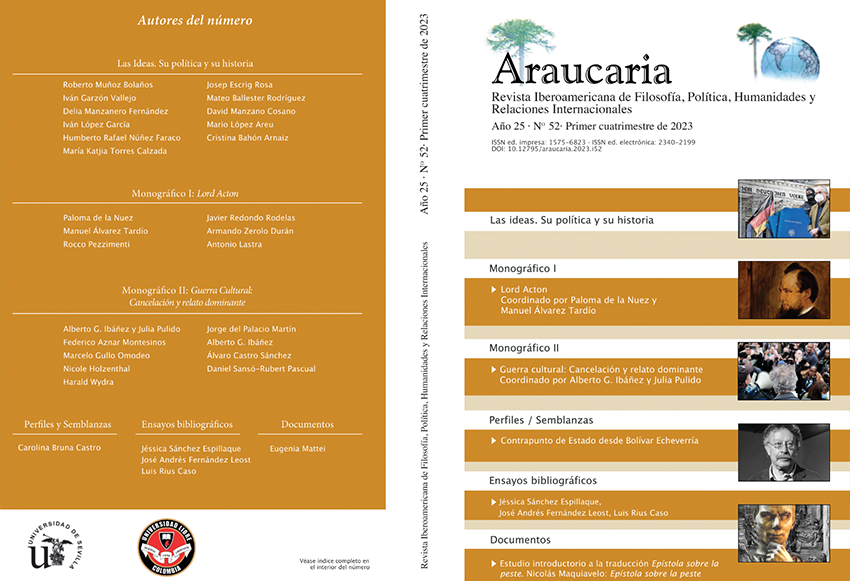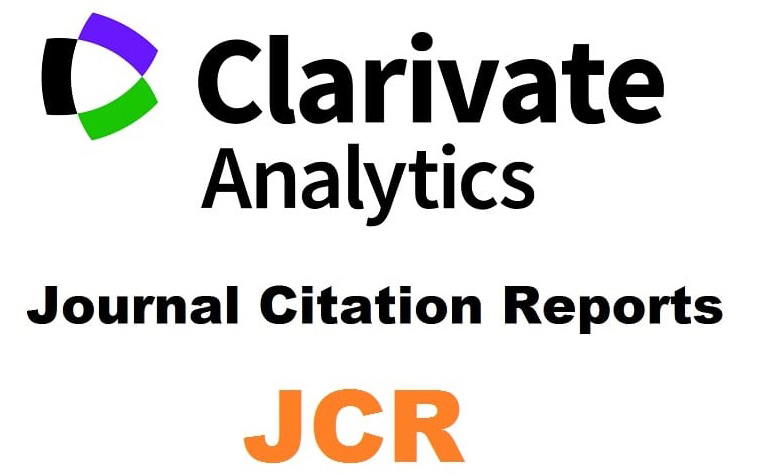A origem dos novos movimentos religiosos cristãos na Coréia: o caso da Igreja da Unificação
The origin of the new Christian religious movements in Korea: the case of the Unification Church
DOI:
https://doi.org/10.12795/araucaria.2023.i52.11Palavras-chave:
novo movimento religioso, Igreja da Unificação, misticismo, cristianismo.Resumo
A presença de novos movimentos religiosos cristãos, também conhecidos como seitas, emboraeste termo inclua uma nuance pejorativa, é cada vez mais evidente na Coreia do Sul. Existem atualmente cerca de dezoito grupos operacionais, entre os quais se destacam cinco: a Federação das Famílias pela Paz e Unificação Mundial, mais conhecida como Igreja da Unificação; a Igreja Shincheonji de Jesus: o Templo do Tabernáculo do Testemunho; A Igreja de Deus Sociedade Missionária Mundial; a Missão Evangélica Cristã, mais conhecida como Jesus Morning Star (JMS); e Guwonpa, também chamada de Good News Mission. Este trabalho investigará a origem dos primeiros novos movimentos religiosos cristãos, surgidos no norte da península durante a ocupação japonesa, bem como sua expansão para o sul com o fim da Guerra da Coréia. Por fim, terá como foco o grupo cristão mais influente do país em nível nacional e internacional: a Igreja da Unificação.
Downloads
Referências
Almarza, Rubén, Breve historia de Corea (Madrid: Ediciones Nowtilus, 2021).
Bae, Jin-young, A Study on the Western artist group in Busan, in the first half of the Korean War since the establishment of the Korean government -Related to the Political Ideology of the Lee Seung-Man Government-, Hangdo Busan, 35, 91-123, (2018).
Barker, Eileen, The Unification Church, Alternative Spirituality and Religion Review, 9(1), 223-229, (2018).
Beascoechea, Ana de Zaballa , La discusión conceptual sobre el milenarismo y el mesianismo en Latinoamérica, Anuario de Historia de la Iglesia, 10, 353-362, (2001).
Cha, Ok-soong, Hanguk geuriseudogyogye sinjonggyo undongui heureumgwa teukjing: Sincheonjireul jungsimeuro 한국 그리스도교계 신종교 운동의 흐름과 특징: 신천지를 중심으로 [New religion movement of Korea and its characteristics: Shincheonji of Christianity], Hangukjonggyo, 38, 159-191, (2015).
Choi, Jung-hyeon, Hanguk mesiaundongsa yeongu 한국 메시아운동사 연구 [A study on the history of the messianic movement in Korea], (Seoul: Saenggakaneun baekseong, 1999).
Euh, Choon-soo, Hanguk gidokgyoui sinbijuuie gwanhan yeongu 한국 기독교의 신비주의에 관한 연구 [A Study on the Mysticism of Korean Christianity], Tesis doctoral, Yonsei University, (2008).
Gardini, Walter, Aportes del cristianismo a la cultura coreana, Oriente-Occidente, 6(1-2), 95-108, (1985).
Henderson, Gregory, Korea: The Politics of the Vortex (Cambridge, MA: Harvard University, 1968).
Jong, Won-lee, The Impact of the Korean War on the Korean Economy, International Journal of Korean Studies, 5, 1, (2001).
Kim David y Bang Won-il, Guwonpa, WMSCOG, and Shincheonji: three dynamic grassroots groups in contemporary Korean Christian NRM, History, Religions, 10(3), 212, 1-18, (2019).
Kim, Heung-soo, Idan ttoneun hangukjeok gidokgyo: Tongilgyo, Jeondogwan, Yongmunsangidowonui jonggyoundong 이단 또는 한국적 기독교: 통일교, 전도관, 용문산기도원의 종교운동 [Heresy or Korean Christianity: The Religious Movements of the Unification Church, the Olive Tree Movement, and the Yong Moon San Prayer Mountain], Jonggyowa munhwa, 23(0), 15-36, (2012).
Kim, Jong-suk, Hanguk mesiaundongsa yeongu 한국 메시아운동사 연구 [A study on the history of the messianic movement in Korea], (Seoul: Cheongnyeonsa, 2010).
Kim, You-joon, 1920-30nyeondae Gil Seon-juui jongmallonjeok buheungundong - Jongmallonjeok naeyeongwa sinsachambae jeohangui oeyeoneul jungsimeuro 1920-30년대 길선주의 종말론적 부흥운동 -종말론적 내연과 신사참배 저항의 외연을 중심으로 [Gil Seon-Ju on the Eschatological Revival Movements in the 1920-30s], Daehakgwa seongyo, 31(0), 165-198, (2016).
Lee, Hyoung-sik, Josyupa Terauchi Masatakewa Joseon tongchi 조슈파 데라우치 마사타케(寺內正毅)와 조선 통치 [Chosyu clique Terauchi Masatake and Japanese colonial rule], Yeoksawa damnon, 91, 5-52, (2019).
Lee, Sang-gue, The false revelation movement in Korean church history, Bible and Theology, 12: 114–20, (1992).
Montemayor, Juan de, La secta Moon: carrera política y estrategia internacional, (Madrid: Iepala Editorial, 1989)
Moon Sun-myung, Wolli gangnon 원리강론 [Divine principle], (Seoul: Seonghwachulpansa, 1966)
Moraleda, José, Las sectas hoy: nuevos movimientos religiosos (Santander: Sal Terrae, 1992)
No, Chi-jun, Iljeha hangukgidokgyo minjogundong yeongu 일제하 한국기독교 민족운동 연구 [A Study of Korean Christians’ Nationalist Movements under the Japanese Rule] (Seoul: Hanguk gidokgyo yeoksa yeonguso, 1993).
Oosterwal, Gottfried, Messianic Movements, Philippine Sociological Review, 16 (1/2), 40-50, (1968).
Park, Chul, Gregorio de Céspedes, primer visitante europeo de Corea, Revista Española del Pacífico, (3), 139-148, (1993).
Park, Young-shin, Sahoeundongeuroseoui samirundongui gujowa gwajeong 사회운동으로서의 삼일운동의 구조와 과정 [The Structure and Process of the March First Movement], Hyonsang-gwa Insik, 3(1), 5 – 32, (1979a).
Park, Yong-shin, Protestant christianity and its place in changing Korea, Social Compass, 47(4), 507-524, (2000).
Ro, Kil-myung, Hanguk minjok jonggyo undongsa 한국민족종교운동사 [History of Korean National Religion Movement], (Seoul: Hangunk minjok jonggyo hyeobuihui, 2003).
Rucquoi, Adeline, Mesianismo y mileranismo en la España Medieval, Medievalismo: Boletín de la Sociedad Española de Estudios Medievales, 6, 9-32, (1996).
Son, Bong-ho, Jonggyowa seong (Tongilgyoui seonggwaneul jungsimeuro) 종교와 성 (통일교의 성관을 중심으로) [Religion and gender (Focused on the Unification Church's gender view)], Sinhakjinam, 173, 78 – 84, (1976).
Tark, Ji-il, Moon Sun-myung sahuui tongilgyo, eodiro gal geosinga? 문선명 사후의 통일교, 어디로 갈 것인가? [The Unification Church after the death of Sun Myung Moon, where will it go?], Gidokgyosasang, 42-49 (2012)
Tark, Ji-il, Hanguk idanui Seryeyohan ihae 한국 이단의 세례요한 이해 [Understanding John the Baptist in Heretical Teachings in Korea], Sinhaksasang, 177, 169-197, (2017).
Yang, Pyun-seung, Hangukjeonjaengi sinjonggyo hyeongseonge michin yeonghyange daehan yeongu ttongilgyoreul jungsimeuro 한국전쟁이 신종교 형성에 미친 영향에 대한 연구 -통일교를 중심으로 [A Study on the Influence of the Korean War on the Formation of New Religions-Focusing on the Unificationism], Sinjonggyoyeongu, 25, 25, (2011).
Yi, Son-gun, Hanguksa Choegeunsepyeon 한국사 최근세편 [History of Korea: The Modern Period] (Seoul: Chindan-hakhoe, 1963).
Yu Wan-sik y Kim Tae-seo, Bukan 30nyeonsa 북한 30년사 [30 years of North Korean History], (Seoul: Hyeondaegyeongjeilbosa, 1975).
Downloads
Publicado
Como Citar
Edição
Seção
Licença
Las ediciones impresa y electrónica de esta Revista son editadas por el Secretariado de Publicaciones de la Universidad de Sevilla, siendo necesario citar la procedencia en cualquier reproducción parcial o total.Salvo indicación contraria, todos los contenidos de la edición electrónica se distribuyen bajo una licencia de uso y distribución “Creative Commons Atribución-NoComercial-SinDerivar 4.0 Internacional”








